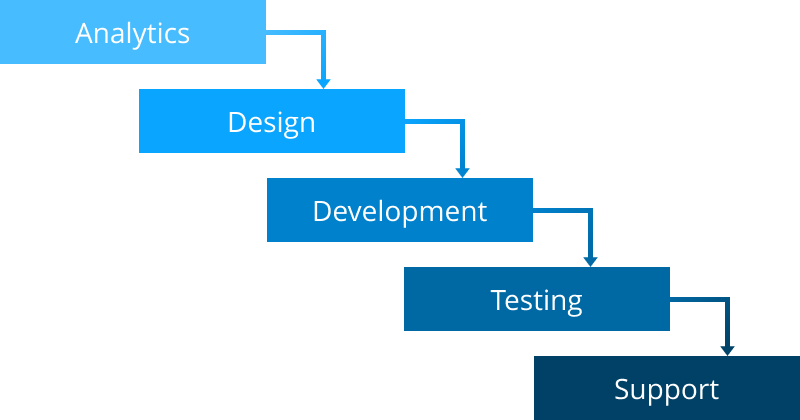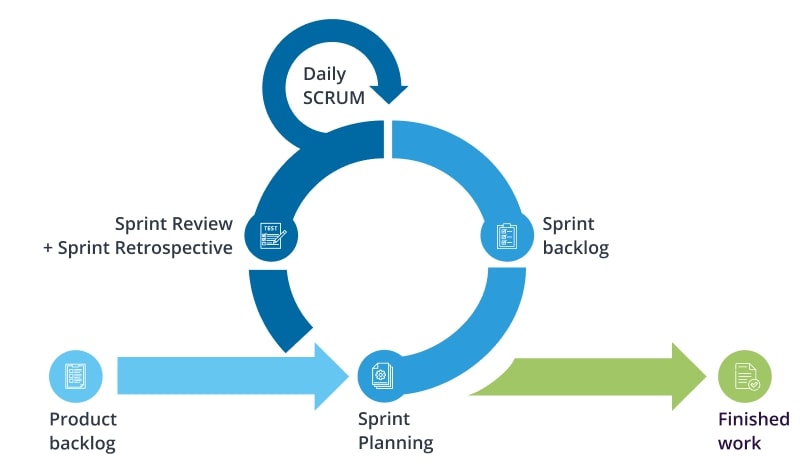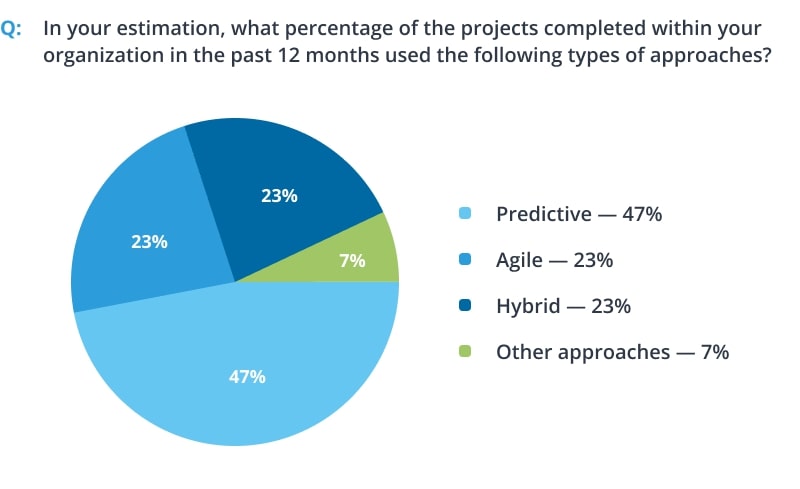Why and How to Use Hybrid Project Management Approach

IT copywriter
Reading time:
Imagine that you have found a dream team for your new project. Then a project manager asks: “What methodology do you prefer to work with — Agile or Waterfall?”. It seemed like a great start, and now you’re at a dead end. Which approach suits your project best? With cascade, the project is split into linear sequential stages without setting aside from a plan. Agile allows making changes during software development process. Don’t panic! Just take the best from each of them. Keep reading to learn why and how to use hybrid methodology from our web development 10,000+ man-hours project case.
Types of project management methodologies
Before we dive into the specifics of the hybrid project management methodology, let’s start off with a brief overview of some popular approaches to project management.
Waterfall
Waterfall is the traditional project management approach where each stage strictly follows the previous one, step by step. Concerning software development projects, it looks like this:
To move along with the Waterfall project, you need to have a clear technical task and an understanding of the steps. But in practice using the Waterfall model alone in most cases is not reasonable. It often turns out that the requirements change or you need to roll back to the previous stage and do it in parallel with the current stage.
For projects where “sidetracking” is acceptable, there is Agile.
Agile
Agile is a family of agile approaches to software development. It assumes that when implementing a project, you do not need to rely only on pre-created detailed plans and requirements. It is also important to focus on the constantly changing conditions and take into account the feedback from customers and users. This encourages developers to experiment and seek new solutions without being constrained by rigid frameworks and standards.
Agile has become the foundation for a number of Agile practices, including:
- Scrum
- Kanban
- Extreme Programming
- Lean, and more.
Essentially, these frameworks involve iterative work on a project – where the key project phases are cyclically repeated one after another.
Scrum is the most common Agile framework. It is a set of principles on which the development process is built, which allows, in rigidly fixed and short-term iterations, called sprints, to provide the end-user with working software with new features for which the highest priority is determined. New features to be worked on during the sprint are determined during the planning phase and cannot be changed throughout its duration. Sprint time is also regulated at the planning stage and is constant, which makes the process of creating a product predictable and flexible. It can be schematically depicted as follows:
Kanban is a visual system for managing work. It visualizes both the process and the actual work passing through that process. The objectives of implementing Kanban is
- to identify potential bottlenecks in the process and fix them
- to create a workflow that proceeds smoothly at an optimal speed
The goal of Extreme Programming or XP is to cope with the ever-changing requirements for a software product and improve the quality of development. Therefore, XP is well suited for complex and uncertain projects.
The XP methodology is built around four processes:
- coding
- testing
- designing
- listening
In addition, Extreme Programming is based on values:
- simplicity
- communication
- feedback
- courage
- respect
Lean is a philosophy of lean thinking. This approach allows you to save resources and get better results. The core principles of Lean are:
- To eliminate losses. It means that if the action does not improve the quality of the product, does not bring profit to the customer and does not save the developer’s time, then it should be excluded.
- To make important decisions at the last moment. Sometimes a late decision can ruin the whole work done, but for Lean, delaying a decision until the last is a way to gather as much information as possible about an issue. This means to be confident in its correctness and avoid mistakes.
We have explored the differences between Agile and Waterfall in this blog post.
What is a hybrid approach in project management?
The word “hybrid” tells us that the concept is about combining two or more separate elements. In project management, it is most common to combine two of the most popular methodologies, which are Waterfall and Agile.
The point of the hybrid project management approach is to choose the most suitable methodology for each project phase. This allows project managers to leverage the strength of their chosen approaches, while also navigating around their weaknesses or potential pitfalls. For example, you can plan and define requirements with Waterfall, and design, develop, and test with Agile.
When to choose a hybrid project management approach and why?
Although Waterfall and Agile sound more familiar, a hybrid method is also popular. Project Management Institute found that project managers in IT, telecom, energy, healthcare, construction, and the government used the “hybrid” method in 23% of projects.
Methodologies are not magic wands. But it’s possible and necessary to understand the principles and take the best from different approaches. The hybrid software development methodology is useful because it allows you to:
- plan and define requirements with Waterfall, and design, develop and implement for Agile,
- organize work more predictably,
- adjust processes to changing conditions and evolve them as the product is developing.
This approach is best suited to large, complex projects that require that you:
- release new functionality frequently,
- adapt to nontransparent requirements,
- meet strict deadlines,
- take into account that the customer wants to take a minimal part in the project.
Example of hybrid method implementation
How you can overcome the difficulties and blend Waterfall with Agile to get the results you want? Let’s see the example from our practice of how we applied a hybrid project management approach to a 10,000+ man-hours development project.
We partnered with “Spasibo from Sberbank” — a loyalty program for cardholders of Sberbank, one of the leading banks in Russia came to us. The client decided to develop a web portal for their new traveling-related service. That meant:
- the project would be large-scale,
- organize with a nonstandard solution so that to launch portal on time.
We had to speed up and act rapidly. While we were planning the work, the client already has running future portal ads on federal national TV. Thus we faced with the following conditions:
- to accept general, unclear requirements: A4 sheet specification,
- to consider the launch date as the client chose release date,
- to adhere to the initially approved budget,
- to observe the infrastructural and organizational restrictions: provide a full product launch cycle and support the Law on Personal Data Protection.
But that was not all. Here came the challenges:
- There was no product owner and tech specialist from the client’s side.
- There was no relevant API from partner companies’ side
- We couldn’t generate test data because we integrated the portal with third-party systems.
- There was no understanding of the predicted system load at launch.
Taking into account such input data, we decided to use a hybrid approach, and split the work into two activities:
1. Interaction with the client.
When it came to communications with the client, we used the cascade method:
- set and agreed on MVP
- selected a team so that they would focus on this project only: project manager, analyst, frontend and backend developers, tester
- agreed on deadlines for MVP presentation
2. Teamwork
As the project team, we decided to use a flexible method — with a backlog and weekly sprints. Here another challenge went: the person responsible for the project from the client’s side was not involved enough. But we understood that it’s important to regularly prioritize and control the tasks for a high-quality result. The solution was to allocate the project manager for this role. Every week we watched and corrected our plans depending on whether we can complete the main pool of tasks. Focused on improving usability.

How to organize processes with “hybrid”.
The chosen work pattern helped us release the project on time. The client was satisfied with the result, so we started maintenance. This stage turned out to be challenging as well. The client planned to develop new functions and bring new partners. Meanwhile, they expected the same effective work from us and the number of tasks grew every day.
To cope with the load, we adjusted the changing condition — with the help of the hybrid approach:
- picked up a team for a given pace,
- optimized processes: minimized internal reporting to speed up the development,
- agreed with the client to coordinate the work, not in the context of large functional, blocks but individual tasks — this allowed us to build the process more predictable.
The project’s success heavily depended on communication and project management skills. We managed to do that. Today the web portal helps to search and buy airline tickets, book hotels, and purchase tours on commercially attractive terms. The platform has a flexible system of content management and a convenient user interface.

We are still supporting the portal: by now we have spent more than 10,000 man-hours on the entire project!
How to apply hybrid project management
Create your recipe for success with a hybrid that suits the conditions and requirements of your project best. Consider these tips to make the most of it:
1.Define project features:
- scope
- complexity
- frameworks and restrictions: fixed or changing
- deadline: strict or flexible
- budget: flexible or fixed
- product availability
2. Select a team with strong hard and soft skills.
Professional skills and expertise are crucial. But strong interpersonal, decision-making, and problem-solving skills, as well as commitment, are no less important.
3. Adjust the processes in the project’s flow.
Track and analyze the project’s progress regularly. Set benchmarks to evaluate how effective the new processes are. Keep track of what’s going well and where changes are required.
Do not choose a project management methodology proceeding from how you’re used to working. Make sure that the team has the necessary skills. Consider your goals and involvement in the project. At Azoft, based on our experience, we have come up with hybrid project management model. It combines the advantages of Waterfall and Agile: phase splitting, iterative processes, and the dedicated role of a project manager that can combine product owner functions. We hope that our recommendations and experience will help you make the best possible decision!
If you need help with managing your project, don’t hesitate to reach out to us!





Comments